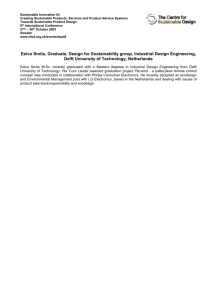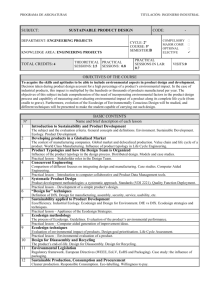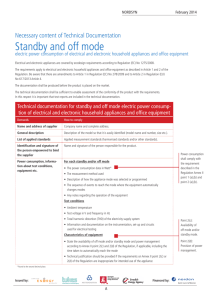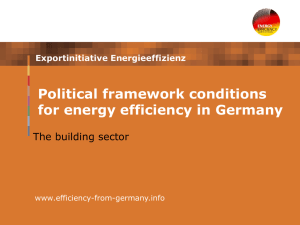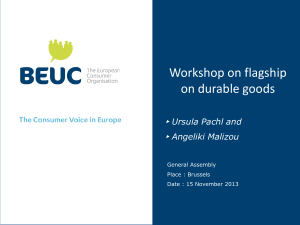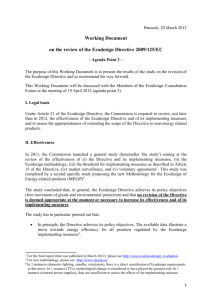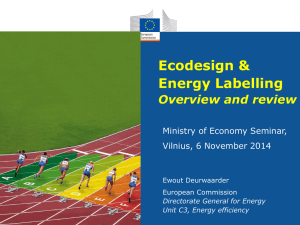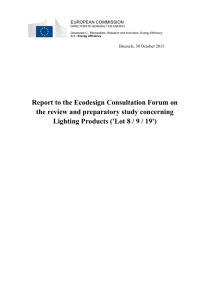Workshop VI: Eco– Design and Understanding a Lifecycle Approach
advertisement
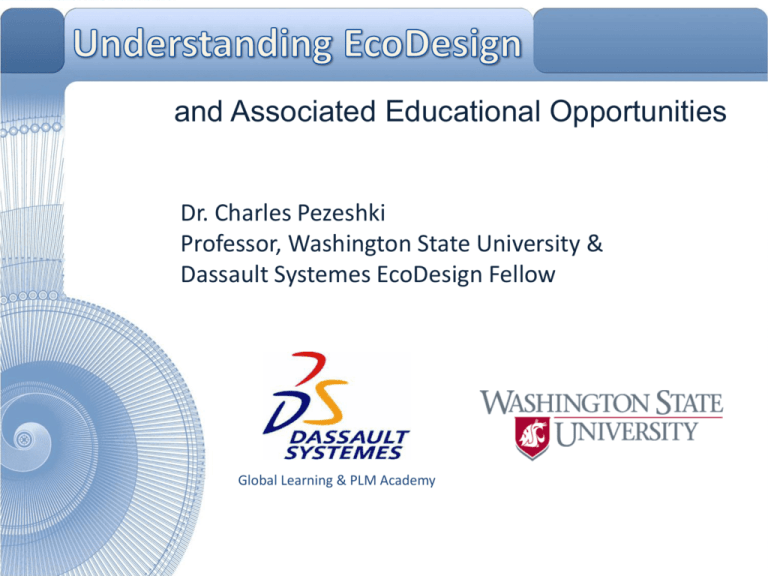
and Associated Educational Opportunities Dr. Charles Pezeshki Professor, Washington State University & Dassault Systemes EcoDesign Fellow Global Learning & PLM Academy Dassault Systemes Technische Universität Wien University Partners Industry Partners • Xavier Fouger • Wolfgang Wimmer • TU Wien, TU Darmstadt, TU Denmark, TU Delft, TU Sydney, ETH Zurich • Priestman-Goode, InterfaceFlor, OMODO, Engel, Steelcase • Ecodesign is incorporating environmental considerations into the Product Design process in a way that tracks the product’s performance and impact over its entire lifecycle. • These considerations can come from a variety of areas, including – internal requirements – governmental regulation – profit-improvement motivations. • All schools and companies visited were wellgrounded in the regulatory environment in Europe. • Everyone had done a project looking at what actual regulations are and what they can mean. • Very little subjective, politicallybased worldview injected into the research. Internal Requirements Philips ‘Flagship Green’ Program for rewarding Green Innovators inside Philips Global Governmental Regulation CAFÉ standards in the US, to the European Commission’ s Framework Directive for Setting Eco-Design Requirements for Energy-Using Products. Paul Priestman—perception of the design industry and designers. Miriam Turner, Interface & Richard Hurding, OMODO—Corporate structure and internal benchmarking. Tim McAloone and Niki Bey— role of academics and developing alternate business models. Wolfgang Wimmer —structured design process for making intelligent ecodesign decisions. Ab Stevels—Bottom-up approach to eco-design. Piero Colonna—success can be technologically project-specific (working fluid for Rankine Cycle). Doug Tomkin—Actual effect of ecomarketing and the developing trend toward ecodesign as accepted excellence. Reiner Anderl —Importance of PLM as bedrock for Ecodesign/ Facilitated Design Processes. Han Brezet—Branching out toward Sustainability for a bigger worldview and an engagement model for students. OnePlanet- Avaloop—creating gateway modalities for students into ecodesign. • Final Consideration – something that can be adapted for both U.S. BS requirements, Euro B and M in Engineering, and the preBologna accords Diploma. • Many different people doing many different activities. • Any framework must be Inclusive—not Exclusive. using reference models and visual feedback to optimize environmental performance • CATIA – generic chair model generated from Steelcase examples, using real data – material library generated manually using product class data • Not in CATIA (illustration) – color scale and corresponding data output (Photoshop) – suggested link to material library (with materials sorted by relative environmental impact) – CO2 data for five sub-assemblies are color-coded only; numeric values are not input as new material properties in the material library. EcoDesign analysis by Hessam Ostad, TU Wien Reference, Parametric EcoDesign: An Integrative Approach for Implementing EcoDesign into Decisive Early Design Stages CATIA illustration by Kelley Racicot EcoDesign analysis by Hessam Ostad, TU Wien Reference, Parametric EcoDesign: An Integrative Approach for Implementing EcoDesign into Decisive Early Design Stages CATIA illustration by Kelley Racicot Implementing EcoDesign Framework and Visual/PLM Technologies in Undergraduate Curriculum • PLM in the Freshman Year • Environmental Policy/understanding of regulatory environments, processes, impacts and motivations • modification of biology course • dissemination of computer tools in the curriculum for more complex examples • capstone project • engineering economics from lifecycle savings. u u Gened 110 [A] GER World Civilizations 1 Ecodesign Note: Influence of environment- material forces on history as a side topic (resource depletion, weather changes, Little Ice Age, emphasis on materials as a key societal definition), Resource Consumption, Availability over Time Books – Guns, Germs and Steel, Jared Diamond Math 171 Calc I [N] GER Getting started without Chem 105/115 Chem I [P] GER core science pre-requisites ME 120 Innov in Design Ecodesign Introduction to PLM – Solids Modeling Focus on PLM, ecodesign background & contextual examples that motivate students u Engl 101 Comp [W] GER 3 4 4 2 3 1 6 Gened 111 [A] GER World Civilizations 2 Same as World Civilization I u Math 172 Calc II Chem 106/116 Chem II [P] GER Ecodesign-related Case Studies for example: Combustion Cycles, Ozone Depletion Causal Chains of events Major Env. Chemical Impact Classifications (IPCC – Int’l Panel on Climate Change) ME 103 Engr. Graphics Ecodesign- related Introduction to PLM – Solids Modeling, u Basics of PDM BioS Elective [B]GER Ecodesign Background Nanoscale, Chemical Scale, Large Scale Biological Phenomena and their effect on the world and its biosystems Topics such as effects of plastics in ecosystems – phthlalates, estrogenizers, Global Warming, ocean impacts and changing climate Causal Chains of Events 3 4 4 3 3 17 complete writing portfolio Math 220 Lin Alg 2 Math 315 Diff Equations Math 273 Calculus III 2 ME 212 Dynamics u Phys 201 Engr Physics I [P]GER 4 Introduction to the Design Process C E 215 Mechanics of Materials u CE 211 Statics 3 Phys 202 Engr Physics II [P]GER Computer Programming* 2 EconS 102 Macroecon [S] GER Ecodesign Enhancement Understanding from a Case Study perspective on the effects of regulations on economic environments, trade-offs and cause and effect 3 Voluntary compliance and eco-labeling 3 ? Sophomore Design Clinic Cross-Spectrum Design Projects Ecodesign Content Benchmarking across the Lifecycle Thinking (also applicable to all performance criteria) ? Sophomore Design Clinic Introduction to the Design Process, Specification Writing Ecodesign Content Lifecycle Analysis, considerations 16 Hands-on design ME 220 Materials Lab clinic leverages students’ visual technology skills to consider environmental, regulatory, Hum Elec [H, G]GER** and economic New Course Local, State, Regional, National and International Governmental and Regulatory Systems – how trade-offs, benchmarking they work, stakeholders, case studies of requirements 3 3 3 4 1 17 apply for graduation this semester ME 301 Thermodynamics Ecodesign Cursory evaluation of traditional associated costs (fuel, performance, environment) of all cycles – minor content addition ME 305 Thermal Fluids Lab 2 3 ME 310 Manufacturing Proc. Ecodesign Environmental Impact/ Energy Consumption of processes – modest curriculum change ISO 14001 – Environmental Mgmt Systems 3 3 ME 311 Manuf Lab 1 3 ME 316 Engr Design [M] GER Ecodesign addition of specifications to the design process that consider environmental effects and regulations/ basic LCA Ecodesign Strategies and Principles 3 ME 303 Fluid Dynamics 3 ME 348 Dynamic Systems 3 EE304 Circuits Ecodesign Case studies of changes in the electronics industry due to environmental regs. Energy Consumption—Standby Issues 2 ME 404 Heat Transfer 3 MSE 201(301) Materials Science Ecodesign Toxicity, environmental impact of select materials for case studies – minor content addition Eco-data associated with materials – recyclability, real cost of extraction and processing 3 Making it real– connecting core science and engineering courses with students’ Math/Stat 370 Statistics interests in ecodesign Adding specifications to the design process that consider environmental effects ME 313 Engrand Analysisregulations 17 15 Intercultural Studies [G,I,K]GER 3 ME 401 Mechatronics Ecodesign System monitoring and control regarding energy consumption Understanding system-level tradeoffs 3 ME 402 Thermal Systems Dsgn Ecodesign Overall carbon production calcs. for final project Putting energy considerations into a larger context Tech Elect Ecodesign Materials and material replacement in Ecodesign ME 414 Machine Design Ecodesign calculation of component-level environmental impacts (minimal change) 3 Hum/SocS TierIII[H,G,S,K, T]*** Ecodesign Technology Assessment – how technology affects both consumer and societal behaviors Putting it all together– from system-level trade-offs to calculating component-level impacts Engl 402 environmental [W] GER Senior design puts LCA process to use for corporate clients; social ME 406 Exp Design Lab [M] GER factors 3 3 3 3 ME 416 Senior Design Ecodesign LCA on all products produced. Ecodesign specifications considered in developing HOQ. Application of principles developed in ME 316 3 3 Tech Elect Ecodesign DFM, DFE, Product Service Systems Design Functionality—Design beyond the artifact in a sociotechnical context Industrial Ecology 3 15 15 total credits 128 Incremental Steps towards coordinated curriculum First Steps •Specific course adaptation (TU Wien) •Student-directed ecodesign specialization (TU Denmark) •Comprehensive integrated curriculum (WSU) Next Steps •Individuals get feedback from department/program colleagues •Draft and discuss comprehensive European curriculum at Design 2008 workshop •Disseminate results (viral advertising) Semester Example: TU WIEN First Draft 1 1 2 Course 153.494 Chemistry for mechanical engineers 311.620 Fundamentals of Manufacturing Engineering 307.016 Fundamentals engineering design Present Elektrochemistry and Corrosion, Basic Organic Substances, Lubricants and Additives, Production of Energy, Fuels and Exhaust Fume Treatment At the moment no link to Ecodesign Overview of production technologies as a basis for understanding life cycle modelling First intro of Ecodesign; basics of design as a prerequisite to understand product development and possible product improvements Ecodesign Improvements How/why chemicals contribute to environmental impact, Impact categories such as global warming, acidification, ozone depletion: how were they caused, which chemicals contribute to each impact category and why, chemical reactions, Influence of material choice to manufacturing technologies, impact of manufacturing technologies, Introduction of manufacturing as part of the product’s Life Cycle; impact of manufacturing processes Where and when to start with Ecodesign, introduction of Life Cycle Thinking, Introduction of implementing environmental aspects into product development Introduction of different tools such as QFD, TRIZ Environmental basics of lifecycle thinking integrated early in the curriculum Semester Example: TU WIEN First Draft 3 3 3 4 Course 307.061 Machine Elements and design classes 372.040 Fundamentals of electronics 308.137 Fundamentals of Material Science 330.077 Production Management Present Further design specialisation, Including Life Cycle Thinking into design and design concepts, the cases to be designed by students could already include Ecodesign based calculations and methodologies, Life Cycle Assessment for parts and larger assemblies components of electronics, optoelectronics, sensors and digital technique and power electronics with practical applications Material categories, material properties, different material data Process engineering, organisational aspects in companies How/why chemicals contribute to environmental impact, Impact categories such as global warming, acidification, ozone depletion: how were they caused, which chemicals contribute to each impact category and why, chemical reactions, Standby consumption and relation to electronic circuits, how/why does standby occur, Introduction of directives related to electronic design etc (EuP, RoHs,…) Introduction why/how material production contributes to environmental impact; in a context of Life Cycle Thinking: material choices related to design concepts and further environmental impacts Pointing out relation between applying Ecodesign and changes/visions in the structure of organisations, maybe also cost related discussions, Discussions of where to start to apply Ecodesign in companies, outlook, timeframe Application of Ecodesign Improvements environmental and lifecycle thinking to engineering areas Semester Example: TU WIEN First Draft 5 5 5 Course 302.073 Applied thermodynamics 308.028 Non-Metallic Materials 330.109 Basics of Managerial Accounting Present Energy sources, power plants, generation of energy – understanding basics of energy concepts Polymers and inorganic materials – understanding material properties Life Cycle Costing Introduction of alternative energy sources, energy outlook, an introduction what assessment methods such as the cumulative energy demand means, regional and global energy outlook Same as fundamentals of materials: Introduction why/how material production contributes to environmental impact; in a context of Life Cycle Thinking: material choices related to design concepts and further environmental impacts, Relating LCC to LCT, Introduction of Ecodesign and its commercial benefits Ecodesign Extending lifecycle Improvements thinking to nontechnical areas Putting it all together in ecodesign
